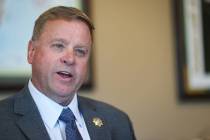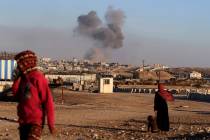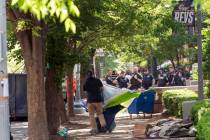Schools face new space issues
To help keep the H1N1 flu virus from quickly spreading through schools in the fall, public health officials and educators will try to give students and staff more space, which could include everything from moving desks farther apart to having classes outdoors.
"This emphasis on space by the CDC (Centers for Disease Control and Prevention) is something new for the schools this year," said Dr. Tracey Green, the Nevada state health officer. "We'll be looking at the way we're gathering people in the schools."
Green's comments came after the CDC released new recommendations Friday on how schools should deal with an expected resurgence of H1N1, or swine flu, in the fall.
Closing schools is now basically a last resort, according to CDC guidelines.
The state's top health official said she has a meeting set for Tuesday with state schools Superintendent Keith Rheault to discuss how schools will address a possible severe flu outbreak in the coming weeks.
"Dr. Rheault will then meet with all the school superintendents to discuss creative approaches," she said.
The CDC's new approaches to creating "social distances within the school environment" if "influenza severity increases" include: rotating teachers between classrooms while keeping the same group of middle or high school students in the same classroom; canceling classes that bring elementary school students together from multiple classrooms; postponing class trips that bring large numbers of students together and discouraging use of school buses and public transit.
"Whatever is decided on will be done at the local level between school officials and the public health officer," Green said.
At this point, Green stressed, the feared mutation of the H1N1 virus -- which could make it far more virulent -- has not occurred. Health officials have described the present H1N1 virus as no more deadly than the seasonal flu.
Most people experience mild illness, though 312 people, including eight stricken in Southern Nevada, have died nationwide from the virus that first hit the United States in the spring.
Seasonal flu regularly kills 30,000 Americans each year.
"Usually we don't get the flu this early," said Green of the virus that continues to spread around the country.
Federal officials said Friday that they hope a vaccine for H1N1 is ready by mid-October. How the vaccinations will be carried out in Clark County has not yet been set.
"We're developing our plans right now," said Stephanie Bethel, a spokeswoman for the Southern Nevada Health District.
Diana Taylor, the director of health services for the Clark County School District, said high schools will be used as points of distribution for the vaccine. She said children are one of the five most vulnerable populations for H1N1 and they will be considered a top priority for the inoculations.
The new school year starts Aug. 24.
Green, who replaced Dr. Mary Guinan as the state's top health official just over a month ago, urged parents to take both children and themselves to physicians as soon as they suspect they have flu symptoms.
Antiviral drugs such as Tamiflu only are effective within 48 hours of the onset of the virus.
If people can't get an appointment with their family doctors, they should go to urgent cares, she said. "People shouldn't try to tough this out if they're sick," she said.
Green said new CDC guidelines recommend that students and staff with symptoms of flu should stay home for at least 24 hours after they no longer have fever, without using fever-reducing drugs.
She said that by late August or early September "a toolkit" for preparing for the flu will be available on the state health division's Web site.
That toolkit, prepared by the CDC, will suggest that parents develop a plan for caring for a sick child at home, which could include identifying a separate room in the house for the ill boy or girl. And one person might need to become the designated caregiver.
Also in the toolkit is information that won't satisfy parents who want specific details about when a school will close. The CDC says schools should be closed only on a case-by-case basis depending on the flu outbreak's severity.
School district spokesman Michael Rodriguez underscored the CDC's position.
"There's no magic number or threshold (of absences)" that would trigger a school closing, he said. "It depends on the circumstance. Every circumstance is different."
The cost to families -- many people don't get paid if they don't work -- caused by shutting down schools is a major factor in keeping schools open until there is no other option.
Common sense should be used in school closures, federal officials said this week.
"We hope no schools have to close, but realistically, some schools will close this fall," U.S. Education Secretary Arne Duncan said last week during an online broadcast. "If you have one child sick, that's one thing. If you have a whole host of children getting sick, that's another," Duncan said.
Review-Journal writer James Haug contributed to this report. Contact reporter Paul Harasim at pharasim @reviewjournal.com or 702-387-2908.
H1N1 virus links:
Federal swine flu planning
Nevada Health Division























